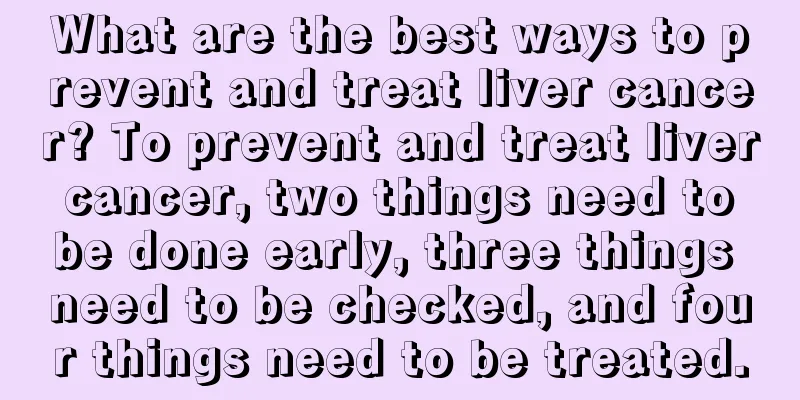What are the best ways to prevent and treat liver cancer? To prevent and treat liver cancer, two things need to be done early, three things need to be checked, and four things need to be treated.

|
Clinical practice has shown that the treatment effects of small liver cancer with a diameter of less than 3 cm and advanced liver cancer are completely different. Advanced liver cancer is often accompanied by intrahepatic and extrahepatic metastasis, which cannot be surgically removed, and interventional embolization and drug treatment are difficult to be effective. However, for small liver cancer diagnosed early, surgical resection, embolization, ablation and other treatment methods are all good. Early prevention is to avoid the spread of hepatitis, avoid liver damage caused by alcohol, drugs, etc., and prevent or alleviate the progression of liver fibrosis to the greatest extent. "Three checks": three-level census management, that is, conducting different checks according to three groups of people. According to the degree of liver cancer risk, people at high risk of liver cancer are generally divided into three categories. The first category is the high-risk group, such as patients who develop cirrhosis due to chronic viral hepatitis (hepatitis B or hepatitis C); the second category is the moderate-risk group, such as patients with chronic viral hepatitis but no family history of cirrhosis or liver cancer; the third category is the low-risk group, such as patients with cirrhosis due to non-viral reasons. The three-level census is to conduct different examinations according to the three groups of people. Generally, the high-risk group should undergo relevant examinations (liver function, alpha-fetoprotein and ultrasound) every three months; the moderate-risk group should undergo examinations at least once every six months; and the low-risk group should undergo relevant examinations once a year. When a suspicious case is found, CT, MRI or arterial angiography should be further performed until liver cancer is ruled out. “Four treatments”: the four commonly used treatment measures for liver cancer. Surgical treatment is traumatic and expensive. In addition, liver lobectomy is affected by factors such as liver function, liver cancer location, and medical technology conditions. It is not an ideal choice for patients with cirrhosis. Local treatment, represented by radiofrequency, is less invasive, causes less damage to the liver, and can be used repeatedly. It has become the preferred treatment method for small liver cancer. The efficacy of interventional embolization therapy is restricted by the blood supply to the tumor artery, making it difficult to completely kill liver cancer cells, and it has no obvious therapeutic effect on the lesions in the liver tissue surrounding the cancer. Drug treatment includes chemotherapy, immunotherapy, traditional Chinese medicine, gene therapy, etc. Drug treatment is only an auxiliary to surgical treatment, and its efficacy is limited when used alone. |
<<: What are the treatments for liver cancer? The three most effective treatments for liver cancer
Recommend
Minimum age for breast cancer
Youngest age for breast cancer 1. Breast cancer i...
Patients are advised to pay attention to the symptoms of lymphoma in advance
Lymphoma is a very harmful cancer disease that ca...
Can washing your face with sulfur soap remove acne?
Most cases of acne occur during adolescence, and ...
Specific requirements for MRI diagnosis of prostate cancer
I believe that everyone has heard of MRI in life ...
What to do if lips are allergic and blistered
For some people with allergies, once they come in...
What to do if acne grows inside the nose
For the young and beautiful girls today, they are...
Who can’t wear small-leaf red sandalwood
Red sandalwood is a material with a light fragran...
What does it mean to live with nasopharyngeal carcinoma
What does it mean to live with nasopharyngeal can...
Why do you scream in a dream
Dreaming is a normal physiological reaction of th...
Introduction to the correct way to wash your face with milk
For female friends who love beauty, they will bra...
The most effective treatment for breast cancer 4 treatments for breast cancer
Breast cancer is a malignant tumor with a high in...
What are the small issues to pay attention to when checking for lung cancer? 7 small issues to note when checking for lung cancer
I believe everyone knows that lung cancer is a ve...
How to differentiate prostate cancer from other diseases
In recent years, prostate cancer has become one o...
What part of the body does acne on the face represent?
Traditional Chinese medicine believes that diseas...
How long does it usually take to conceive after sex
Many people want to have a comprehensive understa...









